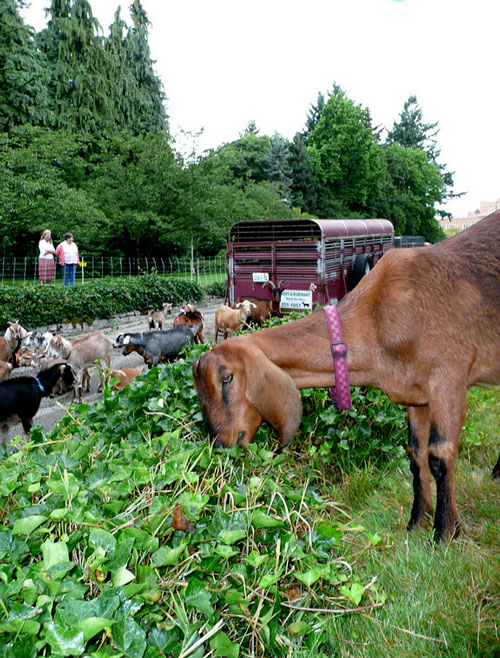Last August I posted some photos from a field tour in Austria where we saw an organic Christmas tree farm that used Shropshire sheep as their principle form of weed control. The particular breed of sheep is suited to the task since they will graze on grass and weeds but not on conifers. Since then I have shared the pictures elsewhere and found out the Shropshire sheep are also employed in the U.S. and the U.K. for similar purposes. Recently, I have had several people share websites for a service known as ‘Rent-a-Ruminant’. As with the Shropshire sheep, these services use grazers to control vegetation, but instead of sheep these companies use goats.

Unlike sheep, goats are much less selective grazers; so call these guys in when you’re in need of land-clearing or invasive species removal. I have seen Rent-a-Rumant advertised in the Pacific Northwest http://www.rentaruminant.com/goats-clear-land.html and in Australia http://thebegavalley.org.au/24484.html so clearly this is a widespread idea. And, I suppose, an example of an old idea that’s new again. As many GP blog readers probably know, I have issues with the ethics (not to mention efficacy) of exploiting grade-school children to pull garlic mustard or purple loosestrife in the name of invasive species control. But using goats to control invasives? That might be a solution everyone can get behind

Not baaaad work if you can get. Rental ruminants chomping on English ivy in the Northwest. (Just for you, Linda)
Hah! I even know where this is! Lower south end of the UW campus in Seattle.
I’ve looked into this a smidge recently and had a question I feel sure you can answer. Do the goats eradicate the invasives in their grazing area or just eat them down to a place where you can then come in and do the eradication yourself? We have many acres of Lonicera japonica that we’d like to remove and I wonder if the goats will kill it or just defoliate it only to have it leaf out again from the naked stems.
I read Bert’s column right after I saw todays Facebook post from the fellow here in Auburn who raises sheep and goats.
http://www.facebook.com/photo.php?fbid=432085163486483&set=a.190882634273405.51069.190864340941901&type=1&theater
I hope the link comes thru OK because the picture is of some of his goats and the caption is “Sorry, Monsanto – these guys just might be more effective than Roundup when it comes to controlling scotch thistle!”
He raises some of the tastiest lambs and goats around and he also hires out his flocks to do weed abatement.
When the goats come to a Seattle neighborhood for a large project, it’s like a fair comes to town- lots of families with kids and joggers milling around, trying to get a good look at the cute goats.
In Oberlin, Ohio, last year there was also a guy with a truck and some sheep, and he’d bring them over to mow your lawn for a fee.
Paul W.
Invasives are invasives because they are tough to kill. Mowing t
hem down once with goats, a mower, or whatever is basically and initial attack. Some may give up after repeated mowings but I suspect in most cases the goats just help to get the situation to a manageable point. I think Jeff has more direct experience than I do, but following the mow-down with something like triclopyr is probably the long term solution. Most difficult weeds and brush just laugh at Round-up.
I agree with Bert – mowing them down won’t do much more than set them back temporarily so you can attack with a different strategy. We haven’t used goats, but when we’ve mowed invasives to the ground and then applied a thick (12″ or so) woody mulch on top, it wipes out all but the most pernicious weeds. This allows the soil to prepare itself for planting something more desirable later. And it avoids (or at least reduces) the use of herbicides. (We published a short paper on this technique back in 2005 in Ecological Restoration.)
I can confirm that goats are indeed used for weed control in Australia. I have used them on my ‘weekender’ country property extensively in the past to clear blackberry. When I bought the place there were blackberry thickets over six feet high in some places. We would tether goats on a small run along the edge of the thickets and periodically moved the run closer as the goats made it disappear. You could probably do it a less finicky way and it’d be easier than our method, but the blackberries in question were growing amongst high quality local vegetation. Goats aren’t picky so we didn’t want them eating the locals. After the goats cleared the thickets we’d wait a couple of weeks then go through and cut and paint the regrowing crowns with glyphosate. Five years down the track and we are by no means free of blackberries – hand pulling seedlings whenever and wherever you see them seems to be a constant task in the warmer months. But no thickets, and the local veg has recognised very nicely. I think the goats also help to disturb the seed bank laying quiescent in the soil too, because we got heaps of local plants germinating in the areas post-clearing. It was a very welcome bonus!
And then there is always this report – http://www.colbertnation.com/the-colbert-report-videos/362220/october-14-2010/people-destroying-america–goats-steal-landscaping-jobs
Bert, you may already know this- but a UGA grad student has developed a goat grazing program to control invasives on the UGA campus. When I was in another SEC town recently – Knoxville – I read that they has used goats downtown to control kudzu.
Interestingly enough, there is the same sort of thing here in Maryland — see http://www.eco-goats.com.